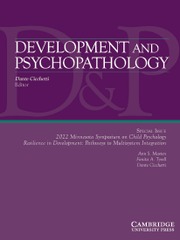Crossref Citations
This article has been cited by the following publications. This list is generated based on data provided by
Crossref.
Llorca-Mestre, Anna
Malonda-Vidal, Elisabeth
and
Samper-García, Paula
2017.
Prosocial reasoning and emotions in young offenders and non-offenders.
The European Journal of Psychology Applied to Legal Context,
Vol. 9,
Issue. 2,
p.
65.
Yoo, Jeong Ah
2017.
Effect of Child Gender on the Bidirectional Relationships between Parental Monitoring and Delinquent Behavior.
Journal of Child and Family Studies,
Vol. 26,
Issue. 12,
p.
3452.
Lauharatanahirun, Nina
Maciejewski, Dominique
Holmes, Christopher
Deater‐Deckard, Kirby
Kim‐Spoon, Jungmeen
and
King‐Casas, Brooks
2018.
Neural Correlates of Risk Processing Among Adolescents: Influences of Parental Monitoring and Household Chaos.
Child Development,
Vol. 89,
Issue. 3,
p.
784.
Stern, Adi
Agnew-Blais, Jessica
Danese, Andrea
Fisher, Helen L.
Jaffee, Sara R.
Matthews, Timothy
Polanczyk, Guilherme V.
and
Arseneault, Louise
2018.
Associations between abuse/neglect and ADHD from childhood to young adulthood: A prospective nationally-representative twin study.
Child Abuse & Neglect,
Vol. 81,
Issue. ,
p.
274.
Flanagan, India M.L.
Auty, Katherine M.
and
Farrington, David P.
2019.
Parental supervision and later offending: A systematic review of longitudinal studies.
Aggression and Violent Behavior,
Vol. 47,
Issue. ,
p.
215.
Racz, Sarah J.
McMahon, Robert J.
King, Kevin M.
Pinderhughes, Ellen E.
and
Bendezú, Jason J.
2019.
Kindergarten antecedents of the developmental course of active and passive parental monitoring strategies during middle childhood and adolescence.
Development and Psychopathology,
Vol. 31,
Issue. 5,
p.
1675.
Russell, Catherine G.
and
Russell, Alan
2019.
A biopsychosocial approach to processes and pathways in the development of overweight and obesity in childhood: Insights from developmental theory and research.
Obesity Reviews,
Vol. 20,
Issue. 5,
p.
725.
Wertz, Jasmin
2019.
Tracing Effects of Parental Discipline on Child Psychopathology: The Devil’s in the Detail.
Journal of the American Academy of Child & Adolescent Psychiatry,
Vol. 58,
Issue. 1,
p.
20.
Walters, Glenn D.
2019.
Mothers and Fathers, Sons and Daughters: Parental Knowledge and Quality of the Parent‒Child Relationship as Predictors of Delinquency in Same- and Cross–Sex Parent‒Child Dyads.
Journal of Child and Family Studies,
Vol. 28,
Issue. 7,
p.
1850.
Kaufman, Tessa M. L.
Kretschmer, Tina
Huitsing, Gijs
and
Veenstra, René
2020.
Caught in a vicious cycle? Explaining bidirectional spillover between parent-child relationships and peer victimization.
Development and Psychopathology,
Vol. 32,
Issue. 1,
p.
11.
Lin, Hua
Harrist, Amanda W.
Lansford, Jennifer E.
Pettit, Gregory S.
Bates, John E.
and
Dodge, Kenneth A.
2020.
Adolescent social withdrawal, parental psychological control, and parental knowledge across seven years: A developmental cascade model.
Journal of Adolescence,
Vol. 81,
Issue. 1,
p.
124.
Stern, Adi
Agnew‐Blais, Jessica C.
Danese, Andrea
Fisher, Helen L.
Matthews, Timothy
Polanczyk, Guilherme V.
Wertz, Jasmin
and
Arseneault, Louise
2020.
Associations between ADHD and emotional problems from childhood to young adulthood: a longitudinal genetically sensitive study.
Journal of Child Psychology and Psychiatry,
Vol. 61,
Issue. 11,
p.
1234.
Zhu, Xiaoqin
and
Shek, Daniel T. L.
2020.
The Influence of Adolescent Problem Behaviors on Life Satisfaction: Parent–Child Subsystem Qualities as Mediators.
Child Indicators Research,
Vol. 13,
Issue. 5,
p.
1767.
Jurczyk, Marcin
and
Lalak, Danuta
2020.
Aggressive and Delinquent Behavior Among Youth: An Empirical Study in Poland.
Violence and Gender,
Vol. 7,
Issue. 4,
p.
188.
Schenk, Loïs
Sentse, Miranda
Marhe, Reshmi
van Duin, Laura
Engbersen, Godfried
Popma, Arne
and
Severiens, Sabine
2021.
The Longitudinal Interplay Between Social Network and Psychopathology in Multi-Problem Young Adult Men; Separating Within-and Between-Person Effects.
Frontiers in Psychology,
Vol. 12,
Issue. ,
Zhu, Xiaoqin
and
Shek, Daniel T. L.
2021.
Parental Control and Adolescent Delinquency Based on Parallel Process Latent Growth Curve Modeling.
International Journal of Environmental Research and Public Health,
Vol. 18,
Issue. 17,
p.
8916.
Kuo, Sally I-Chun
Salvatore, Jessica E.
Barr, Peter B.
Aliev, Fazil
Anokhin, Andrey
Bucholz, Kathleen K.
Chan, Grace
Edenberg, Howard J.
Hesselbrock, Victor
Kamarajan, Chella
Kramer, John R.
Lai, Dongbing
Mallard, Travis T.
Nurnberger, John I.
Pandey, Gayathri
Plawecki, Martin H.
Sanchez-Roige, Sandra
Waldman, Irwin
Palmer, Abraham A.
and
Dick, Danielle M.
2021.
Mapping Pathways by Which Genetic Risk Influences Adolescent Externalizing Behavior: The Interplay Between Externalizing Polygenic Risk Scores, Parental Knowledge, and Peer Substance Use.
Behavior Genetics,
Vol. 51,
Issue. 5,
p.
543.
Cavanagh, Caitlin
Dalzell, Erica
LaBerge, Alyssa
and
Cauffman, Elizabeth
2022.
The Justice System and the Family: Police, Courts, and Incarceration.
p.
19.
Yang, Kyungsun
and
Chung, Grace H.
2022.
The Process of Mothers’ Adaptation to the Development of Adolescent Children from the Perspective of Monitoring Change.
Journal of Families and Better Life,
Vol. 40,
Issue. 4,
p.
87.
Vaughan, Erin P.
Speck, Julianne S.
Frick, Paul J.
Robertson, Emily L.
Ray, James V.
Thornton, Laura C.
Wall Myers, Tina D.
Steinberg, Laurence
and
Cauffman, Elizabeth
2022.
Longitudinal associations of parental monitoring and delinquent peer affiliation: The potential influence of parental solicitation and monitoring rules.
Journal of Adolescence,
Vol. 94,
Issue. 4,
p.
656.


